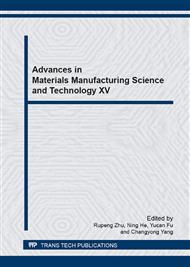p.198
p.202
p.207
p.213
p.217
p.221
p.226
p.230
p.234
Numerical Simulation of Milling Process: A Total Procedure
Abstract:
Milling is one of the most common materials removal processes used in the production of dies, moulds and various aeronautic components. The process performances such as dimensional accuracy, chatter propagation and tool wear are the common problems which can lead to useless workpiece. The traditional method to avoid these problems is the so-called trial and error method, which often has the characteristics of time-consuming. With the advancement of recent computing techniques, one efficient method to determine acceptable process parameters is development of a comprehensive simulation environment. In this paper, efforts are focused on the introduction of a milling simulation procedure proposed recently by the research group of the authors. The key issues such as development of cutting force model, prediction of dimensional errors and stability lobes are described. At the same time, the crucial issues such as calibration of model parameters and simulation algorithms are also highlighted.
Info:
Periodical:
Pages:
217-220
Citation:
Online since:
October 2013
Authors:
Keywords:
Price:
Сopyright:
© 2014 Trans Tech Publications Ltd. All Rights Reserved
Share:
Citation:


